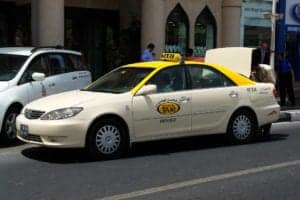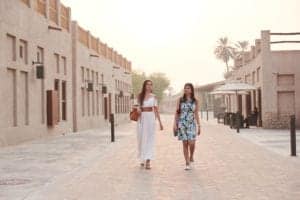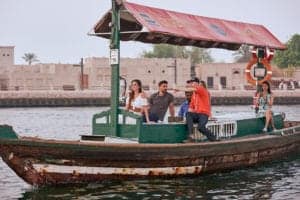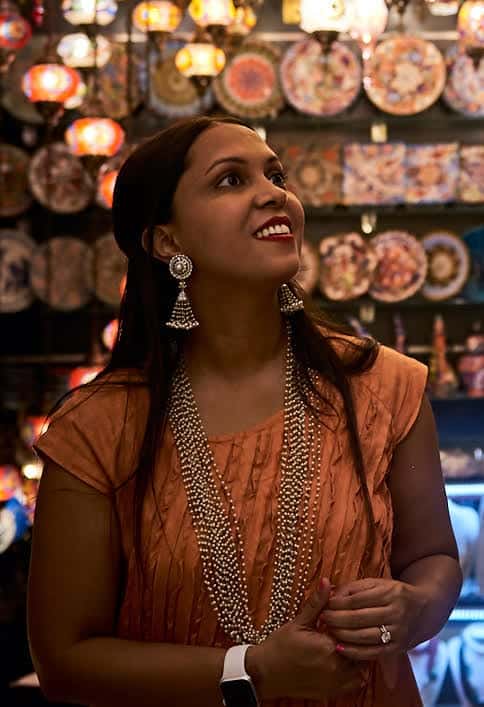Dubai can seem like a shimmering, cosmopolitan maze of glass and metal towers and landmarks plopped down in the middle of the desert. On the first descent into Dubai International Airport, the barren, brown sand dunes give way to a glittery oasis of one of the world’s most vibrant and developed cities.
That said, travel to and in this Arabian city is easy and stress-free. As part of its transition into a tourist-supported economy, Dubai has increasingly built itself up to be a globally accessible hub welcoming to foreign guests and businesses.
With lots of transportation options, getting around Dubai is easy. In this blog, we talk about some of the best ways to get around during your visit.
Trains
With many options to choose from, public transportation in Dubai is the favored choice for many locals and tourists. The city is well connected by buses, metro, and tram.
- Metro
The Dubai Metro is a fully automated, driver less metro network. It runs partly underground and partly via elevated viaducts.
So far, two lines have been constructed. The Red Line runs parallel through Sheikh Zayed Road for a majority of its run. The Green Line runs parallel to Dubai Creek, through Deira and Bur Dubai.
With over 45 stops, The Metro serves the most popular tourist areas within Dubai. Metro fare will depend on the zone you’re traveling in and the distance you travel. There are two options you can choose from: The Silver or the Gold Class. The Gold Class is only one coach on the train and the cost is twice as the tickets to the silver class. Each train has a coach dedicated to women and children. Cabs and supplemental buses are available at most stations and can be used to get you to your destination, if needed, but are typically more expensive.
The Red metro line runs the length of Sheikh Zayed Road, while the green line services the old town area of the city. Most points of interest for a tourist are clustered around Sheikh Zayed, so you’ll be able to hit a lot of the popular attractions solely using The Metro.
There are direct metro stops which will make it easier for you to visit Burj Khalifa, Dubai Marina or even the Al Fahidi Historical Neighborhood.
Before you enter the metro, you would need to purchase a Nol Card for your travel (Nol means ‘Fare’ in Arabic). This can be bought from the customer service counters or from the vending machines. Fare can be purchased and stored on Nol Cards (which can even be used to pay for RTA parking). Cards have to be tapped on the card reader before and after your metro travel. Riders can purchase single or multiple travel tickets for rides. Trains operate within 10-minute intervals during off-peak times and even faster during rush hour. For more details, you can also check our blog on How to use the Dubai Metro!
Two types of tickets are relevant to visitors:
- Nol Red Ticket: (AED 3, plus credit for at least one trip) Must be pre-loaded with the correct fare each time you travel; can be recharged up to 10 times; may only be used on a single mode of transport at a time.
Fares: AED 4 for one zone, AED 6 for two zones, AED 8.50 for three or more zones, AED20 for the day pass.
- Nol Silver Card(AED 25, including AED 19 credit) With pre-loaded credit, this works on the pay-as-you-go principle with fares deducted. Get this card if you're going to make more than 10 trips.
Fares: AED3 for one zone, AED 5 for two zones and AED 7.50 for three or more zones.
- Tram
Operating from the end of 2014, the Dubai Tram runs 14.5 kilometers of Al Sufouh Road. The Dubai tram travels on a specially constructed street-level track to connect the highly populated residential and commercial areas of Jumeirah Beach Residence, Dubai Marina, Palm Jumeirah, Dubai Media City, and Knowledge Village.
The Dubai Tram offers a flat rate of AED 3 per ride per person and AED 6 per ride per person, no matter what your destination is, making it one of the cheapest rides in the city.

The tram connects to two major metro stations- The Jumeirah Lake Towers) now DMCC metro station and the Dubai Marina metro station. Each tram can accommodate 370 passengers at a time in seven coaches, which includes a gold suite and cabin dedicated to women and children.
- Monorail
If you’re planning on spending the day on Palm Jumeirah Island (which we highly recommend!) or visiting Atlantis The Palm, hop on the Palm Monorail.
The Palm Monorail connects Dubai’s mainland with the Palm Jumeirah Island station. There are three stations: Palm Gateway Station near the bottom of the 'trunk', Al Ittihad Park near the Galleria Mall and Atlantis Aquaventure at the Atlantis hotel. Two additional stations, The Pointe and Nakheel Mall, were expected to be up and running by the end of 2019 at the time of research. It’s the perfect way to travel from the city to Atlantis the Palm for a day of fun at Aquaventure Water Park or the Lost Chambers Aquarium. Check our top things to do in Dubai blog post for more details on the Palm Jumeirah and the Atlantis!
The 5.5km trip takes about 12 minutes and costs AED 20 (AED 30 return trip); cash only. Trains run every 15 minutes from 9 am to 10 pm. The monorail links to the Dubai Tram at Palm Gateway.
Travel Hacks for Using the Train in Dubai
- Traffic practically grinds to a halt and metro trains are packed during rush hour, which runs roughly from 7 am to 10 am and 4.30 pm to 8 pm or later.
- Buy a Nol Card before using the metro, local bus, tram or water bus.
- If you're in Dubai on a short layover, buy the rechargeable Nol Red Ticket. Longer stays might warrant getting the Nol Silver Pass.
- On the Dubai Metro, have your Nol Card ready before you go through the gate so as not to hold up people.
Taxis
- RTA Taxi
RTA Taxi is the most convenient and easiest mode of transport in Dubai- you will find them in plenty in Dubai. Fares typically start at AED 5 from all locations except from outside malls, five-star hotels and other popular attractions(Mall of Emirates/ Dubai Mall/ Burj Khalifa, etc), where the fares start at AED 12.
All taxis run on a metered service with the fee charged by distance, so be sure to ask your driver to turn on their meter if they have not automatically done so. RTA taxis are licensed and can be found with red, yellow, blue, green roofs. Taxis with a pink roof are women-driven taxis intended for the use of women and families only.
Be aware that you may experience long wait times for a taxi during rush hour, typically between 3:30 pm and 5:30 pm.
How to Hail an RTA Taxi: Look for a stationary or approaching cab with the yellow light on (red means it's occupied). As the car is approaching, stand in a prominent place on the side of the road and stick out your arm. The driver should pull over when they see you.

Taxi may not always have working credit/ debit card machines and hence having cash can be helpful.
- Careem/ Uber
Dubai is a taxi-centric city, and you're likely to find yourself in need of a cab at some point.As in other metropolises, taxis are facing stiff competition from mobile ride-hailing apps such as Uber and Dubai-based Careem founded here in 2012 and now operating throughout the Middle East. Cost-wise, there's very little difference, but Uber and Careem tend to have much nicer cars that often come with free water, phone chargers, and more clued-up drivers.
Careem and Uber are convenient yet a bit pricey options as compared to the RTA operated Taxis. But you get a premium service with a luxurious car! At peak times, you can pre-book a cab for yourself and easily travel to your destination. The cabs also operate even in late-night hours.
Travel Hacks for Using the Taxi in Dubai
- At night, traveling by taxi is the fastest and most convenient way to get around town.
- For shorter distances, taxis are the fastest way of getting around and not too expensive.
Bus
Dubai’s bus network is an inexpensive way to travel to places that the Metro doesn’t reach. The air-conditioned bus network includes more than 600 bus stops in and around Dubai. Many of the bus stations are also air-conditioned.
Many buses go to the Gold Souk Bus Station. This is close to popular attractions like the fish market, the gold souk, perfume souk, and spice souk.
The buses have pros and cons. The benefits include the low price, and they are air-conditioned. If you get a seat, they are comfortable. The downsides include crowded buses that move very slowly due to the traffic. Some of the stops are also difficult to find.
One thing that you need to remember before hopping onto a local bus or metro is that you need to rechargeable Nol card available from the ticket offices in the metro stations or bus stations. There are four categories of Nol Card. Fares depend on distance and are divided into five zones.
Rental car
You also have the option of renting a car from the airport or at various locations in the city and driving to your destination. Car hire agents with kiosks are available throughout the city like Dollar, Thrift, W&B Rent a Car and Hertz. This is the most expensive option. The prices vary based on the car make, length of rental and the rental company. If you’re thinking about renting a car, you should also remember to include the price of fuel in your estimate (even though fuel in Dubai tends to be cheaper than in other parts of the world) and the price of parking (as there are only a few areas with free parking in Dubai). You should also consider that driving on Dubai’s roads can sometimes get a bit chaotic, so make sure you will be comfortable driving in these conditions.
Landing at the Al Maktoum Airport or the Dubai International Airport, here is our guide on the best ways to commute from the two airports to the city.
Pros: Freedom to travel anytime at your convenience and directly to/from your destination
Cons: This is the most expensive option. You should only consider renting a car if you are planning to make use of the vehicle throughout the length of your trip.
Walk
‘When you walk through a city you are walking through time’
It is said and we believe that the best way to explore a city is to walk. When you walk through a city, you get the real scoop. You see the attractions up-close-and-personal, and really get a feel for the city. Walking through a city also allows you to interact with the locals- the real people of the city. These people make the city what it is – a melting pot of cultures. You can ask questions and engage with the shopkeepers, vendors, cooks, and servers. This will allow you to find out their story and how they fit into the amazing culture of tolerance in Dubai.

Dubai By Foot offers signature walking tours of Dubai. Our tours are designed to explore the different facets of the city. Whatever your interest, be it history, culture, architecture, fashion, art, food or technology, we are sure to have the right tour for you. Our most popular walking tours are the Old Dubai and Souk Walking Tour and the Arabian Nights Tour!
You can also walk in the city with the help of our self-guided tours in JBR Marina or Jumeirah!
Water Transportation
- Abra Boats
What can you get in AED 1? If you seek adventure, then your 1 dirham can let you take an Abra (wooden boat) ride in Dubai Creek.
The saltwater creek is known as the heart of Dubai. It served as a gateway for traders years ago and now became a tourist spot. It divides the city into two main areas, Deira and Bur Dubai. There are buses and trains that can take people to the other side, but the best and fun way to cross it is to ride the wooden boat.

Abras are motorized traditional wooden boats that link Bur Dubai and Deira across the Creek. The fare is Dh1 and they run from 10 am to 10 pm along two routes. It is a very popular way of crossing the Creek and a favorite of many tourists who visit the Old City.
On our Old Dubai and Souk Walking Tour, we take a private Abra to cross the Creek from the Bur Dubai side to the Deira side. The abra crossing of the Dubai Creek is at its most atmospheric after dark.
- Water Taxi and Dubai Ferry
Want to travel the city in style beating the traffic on roads? Water Taxis in Dubai are just for you then. Water taxis are sure pretty—much more enjoyable and relaxing than hailing a cab- to take a more scenic route to any destination.
Water taxis traverse the city’s waterways and are a faster yet a little costly option to travel.
The RTA has an online portal that allows you to now book a Water Taxi online.
Timings: The service runs between 10 am and 9 pm daily. Fares and route Fares and the route will be defined once you have specified your pick-up and destination.
Cost: You can charter a private Water Taxi for Dh200 for 30 minutes, or Dh400 for 60 minutes.
A water ferry is another luxury option but one that is limited to major stop points in Dubai. It also has group events for photography, tea, and visiting the Dubai Marina Mall. Dubai Ferry – The Dubai Ferry is as much a tourist thing to do as it is a public transport system, allowing visitors and residents to view the city from the sea and get a glimpse of some of Dubai’s iconic buildings, such as the Burj Al Arab and the Palm Jumeirah with the majestic Atlantis Hotel. Ferry timings change continually, so click here for a more thorough check. The ferry has comfortable seating, and will only run if there is a minimum of 10 people on board.
Although Dubai is not best known for its connectivity, there are many options for public transport, particularly if you have time and want to experience Dubai from a unique vantage point. Keep our guide handy next time you visit Dubai for an easier commute in the city.






